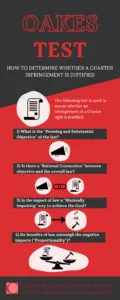"The Canadian Charter of Rights and Freedoms guarantees the rights and freedoms set out in it subject only to such reasonable limits prescribed by law as can be demonstrably justified in a free and democratic society."[1]
Section 1 of the Canadian Charter of Rights and Freedoms (see above) tells us that the Charter protects the specific rights and freedoms laid out in it. However, it also states that these rights and freedoms may be lawfully limited by the state, so long as these limits are “reasonable” and can be “demonstrably justified in a free and democratic society.”[2]
Several years after the Charter was enacted, the Supreme Court of Canada created a general framework for deciding whether government action that infringes a Charter right is justified. This is known as the Oakes test (named after the case in which it was created). Before using this test, a Charter right must be proven to have been infringed. If that is the case, then the Oakes test is used, with the government bearing the burden of proving that it has complied with the requirements of the test and that the infringement is therefore justified. The test consists of four distinct steps:
Step 1 - The government that infringed the Charter right must explain the objective of its impugned law or conduct. The objective must be pressing and substantial.
Step 2 - The government must demonstrate that the law or policy is rationally connected to the pressing and substantial objective. If the law or policy is arbitrary or serves no logical purpose, then it will not meet this standard.[3]
Step 3 - The government must demonstrate that the law or policy is minimally impairing of the Charter right. This means that the law must impair the Charter right as little as possible or is “within a range of reasonably supportable alternatives.”[4]
Step 4 - The government must demonstrate that the beneficial effects of the law or policy are not outweighed by its negative effects on the Charter right in question. This is generally known as the proportionality requirement.
If the government fails at any of the steps within the Oakes test, the infringement is not justified. If this happens, the court will invalidate the law or policy on the ground that is “inconsistent” with the Constitution of Canada.[5]
Although allowing for Charter rights to be infringed may initially appear to undermine them, it can also be viewed as a way of promoting a more balanced approach to rights protection. In this regard, section 1 recognizes that the rights it establishes are not absolute, and allows for conflicts between different rights — and between rights and other societal interests — to be reasonably resolved.

[1] Canadian Charter of Rights and Freedoms, Part I of the Constitution Act, 1982, being Schedule B to the Canada Act 1982 (UK), 1982, c 11, s 1.
[2] Ibid.
[3] R v Malmo‑Levine; R v Caine, 2003 SCC 74, para 90-91, 98.
[4] Alberta v Hutterian Brethren of Wilson Colony, 2009 SCC 37 at para 37.
[5] Being Schedule B to the Canada Act 1982 (UK), 1982, c 11, s 52.





